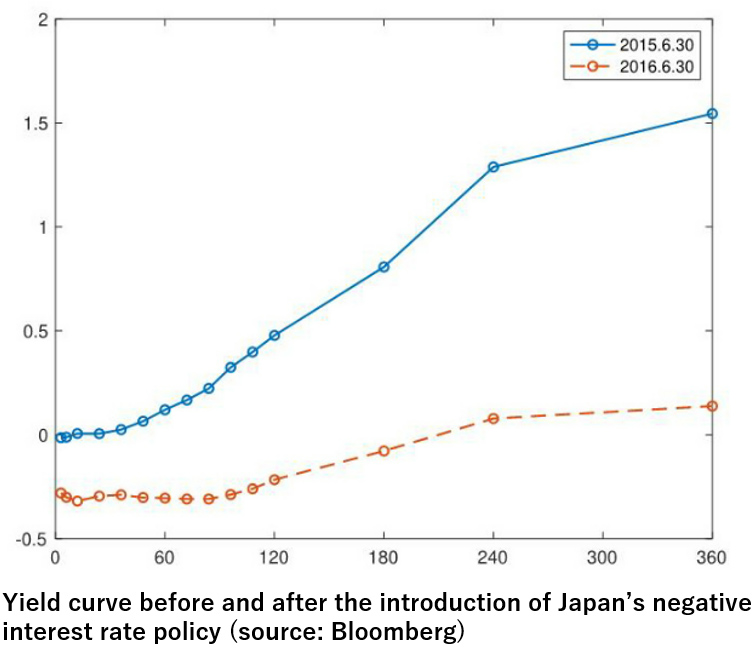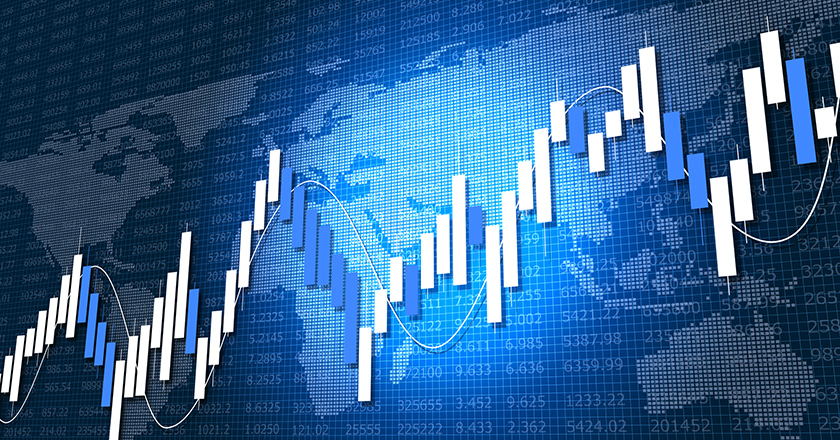The inflation rate, which was around 0% for more than 20 years, moved upward owing to the coronavirus crisis
For a long time, since the mid-1990s after the bubble burst, Japan’s inflation rate has hovered around 0%. The inflation rate is an indicator showing the level of increase in prices. It indicates the increase rate compared with the consumer price index (CPI) from the previous year. In general, economic growth accompanies moderate increases in prices. Japan’s rate hovered around 0% for more than 20 years, and the situation came to be known as chronic deflation.
Deflation is a situation where the value of a currency rises relative to goods. Thus, consumption is delayed and goods do not sell. Then, the performance of companies will suffer, the income of consumers will also decrease, further suppressing their consumption, and companies will have no choice but to lower the price of goods. Such a vicious spiral is likely to happen.
The BOJ (Bank of Japan) has taken various monetary policies to achieve the goal of a 2% inflation rate in order to break away from prolonged stagnation. Around 2% is said to be the global standard of not falling into a deflationary spiral. Japan was not able to achieve that for many years. However, since the coronavirus crisis, the inflation rate has increased, and core CPI inflation surpassed 2% in December 2023, compared with the same month of the previous year. The core CPI is the index among CPIs which is calculated excluding fresh food that is vulnerable to the weather factor, and its rate of change is called core inflation.
On the other hand, the core CPI inflation which is calculated in the U.S. excluding food and energy has hovered around 2% compared to the same month of the previous year since the 2000s. However, after the coronavirus crisis, in June 2022, the index surpassed 9%. Although it is not uncommon for developing countries to see this level of increase within a year, it is an abnormal situation for a developed country.
How did the coronavirus crisis impact the rise in the inflation rate? It is considered that the change in people’s way of working and lifestyle, such as working from home, had a major impact on consumption. Moreover, in the U.S., the inflationary trend already existed, and that was accelerated immediately by the coronavirus crisis. Demand grew and labor supply ran short, wages went up, and inflation advanced further. In the meantime, in Japan, the rise in import prices has been the major cause. It can be said that the increase in the price of raw materials and oil and natural gas has mainly contributed to the inflation.
Negative interest rate since 2016 finally ended, and the rate was raised for the first time in 17 years
The change in inflation rate also affects the setting of the policy interest rate and monetary policy. The policy interest rate is a short-term interest rate that is decided by the central bank (BOJ, in the case of Japan) in order to achieve the monetary policy goal such as stabilizing the economy and prices. Generally, during a strong economy, it is raised to control inflation, and during a sluggish economy, it is lowered to encourage consumption and investment.
The Fed (Federal Reserve), which is the central bank of the U.S., in response to the spread of COVID-19, in March 2020, introduced a zero interest-rate policy, which induces a policy interest rate very close to zero. However, in response to the major rise in prices, it ended the policy in March 2022 to control inflation. As a result of raising the policy interest rate more than 5% within about a year, at the beginning of 2024, the inflation rate approximated the target value of 2%.
When the policy interest rate is raised, the interest rate rises in various markets. Then, what will happen? People think it is better to save money in the bank to use it in the future, rather than using it now, and consumption will decrease. When the interest rate for loans rises, it will also become difficult to buy houses and cars. Moreover, if a company wants to make an investment by borrowing money from a bank, even if it estimates that it will gain 5% revenue, if the bank interest rate is set at 7%, it cannot make an investment because it will incur a loss. In other words, the intention of raising the policy interest rate is to control inflation through suppressing people’s consumption.
On the other hand, after the bubble burst, the BOJ continued the zero interest-rate policy for a long time. However, even that could not help to recover the economy. Therefore, it introduced a negative interest rate policy in 2016. This is a policy to apply a negative interest rate to some of the Bank of Japan current accounts that private financial institutions deposit in the BOJ. Through this it encouraged lending and investment for companies, and tried to invigorate the economy.
Changes in policy interest rates by central banks are shown in the yield curve. Yield curve is a curve expressing the yield of government bonds. It is expressed by showing the period until the redemption of the government bond in the horizontal axis, and the yield in the vertical axis. In general, the yield becomes lower if the period until the redemption is shorter, and higher if the period is longer. However, when the short-term and long-term interest rates decline, owing to the negative interest rate policy and by purchasing long-term government bonds, the yield curve becomes flat. The figure shows the yield curve before and after the introduction of Japan’s negative interest rate policy. Compared to the yield curve on June 30, 2015, before the introduction of the negative interest rate policy, the yield curve on June 30, 2016, after the introduction of the negative interest rate policy, became flat. When the interest rate declines as such, the interest which the domestic financial institutions gain from the deposit decreases, and the revenue will be squeezed. They will then fall into the vicious cycle. Therefore, the BOJ is trying to stimulate the economy by conducting yield curve control that induces the long-term interest rate to around 0%, while applying a negative interest rate to the short-term interest rate.

While the coronavirus crisis was the trigger in the end, in response to the inflation rate rise, it decided to be more flexible concerning the yield curve control in October 2023. It discontinued the restriction of a 1% cap, and set the cap to the yield of the 10-year government bond, which is a long-term government bond, from +0.5% to +1.0%. Along with this, megabanks raised the fixed interest rate for home mortgages. The BOJ also ended the negative interest rate this March and decided to raise the policy interest rate for the first time in about 17 years.
Healthy economy raises wages while restraining significant inflation
Inflation due to the coronavirus crisis is a worldwide trend. Not only in the U.S. but also in Europe, the EU central bank called the ECB (European Central Bank) raised the policy interest rate and is trying to control inflation across Europe, and especially in the EU. Current inflation in Japan is influenced by foreign trends, and its rate is significantly lower than that abroad. The long-term interest rate is also at a very low level. The BOJ, which finally managed to end its negative interest rate, may look abnormal from abroad.
One of the causes that led to the decades of deflation in Japan was the weakness in domestic demand. While in the U.S. the domestic demand is strong, Japan is dependent on external demand. If the external demand becomes stronger, export companies can earn more, but such impact is limited. Furthermore, in the case of Japan, it is mainly related to the fact that wages are not increasing. If prices decline, companies cannot gain revenue and cannot raise wages. Because of that, consumption will also be restrained. This vicious cycle has continued.
Currently, consumer prices are increasing without wage increases. Therefore, people try to save for the future by reducing their consumption. I feel that it is moving in the wrong direction. Recently, while the average hourly pay in the U.S. exceeded 5,000 yen, we heard the news that Japan finally broke the barrier of 1,000 yen. Surely the current currency rate is reflected. Even then, the gap is becoming wider.
Changes in import and commodity prices are said to have the “first-round effect,” which pushes up consumer prices directly by rises in raw material prices, etc., and the “second-round effect,” which pushes up prices further, when the primary effect spreads throughout the entire economy, and the wage rises through the increase in prices. In Japan, the current domestic prices are increasing simply because goods from abroad are expensive on a yen basis. Thus, if foreign inflation comes down and the import price drops, such situation will come to an end. Whether Japan can maintain an around 2% inflation rate properly is related to future monetary policy, and furthermore, wage increases by companies.
A healthy economy raises wages while restraining soaring inflation. In the past, Japan also experienced continuous wage increases. However, since the bubble burst, companies have been hesitant to increase their wages. However, in response to the cheap yen, some major companies and export companies have achieved record high profits. I hope such companies will initiate pay rises and that will have repercussions on other companies.
From now on the population will decline, and it will become more difficult to secure manpower. Therefore, it is important to raise wages and continue to be an attractive company for workers. If there is no base-pay increase, consumption will not increase either. So far, measures for that have been limited to calls from the government. How should the policy be advanced and how should companies respond from now on? Cooperation between the public and private sectors is essential for the recovery and stability of the economy.
* The information contained herein is current as of July 2024.
* The contents of articles on Meiji.net are based on the personal ideas and opinions of the author and do not indicate the official opinion of Meiji University.
* I work to achieve SDGs related to the educational and research themes that I am currently engaged in.
Information noted in the articles and videos, such as positions and affiliations, are current at the time of production.

